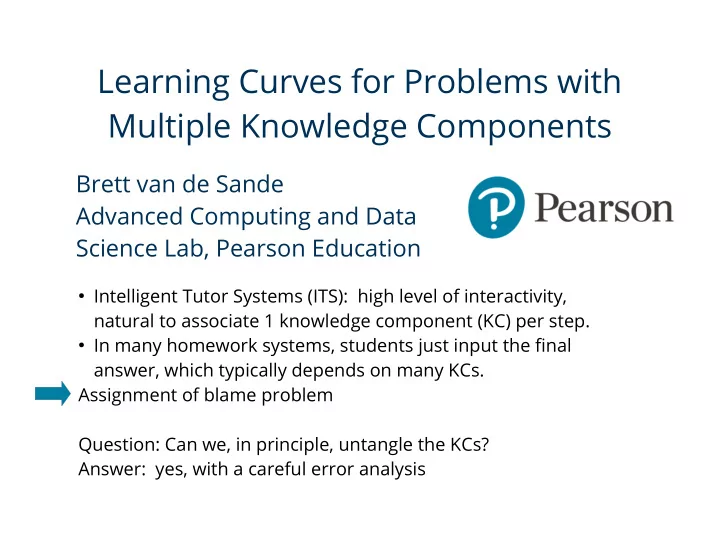

Learning Curves for Problems with Multiple Knowledge Components Brett van de Sande Advanced Computing and Data Science Lab, Pearson Education ● Intelligent Tutor Systems (ITS): high level of interactivity, natural to associate 1 knowledge component (KC) per step. ● In many homework systems, students just input the fnal answer, which typically depends on many KCs. Assignment of blame problem Question: Can we, in principle, untangle the KCs? Answer: yes, with a careful error analysis
The model ● Simplest possible: ● P t,k is the probability that a student will apply KC k correctly on opportunity t . ● Use the set { P t,k } as the model parameters. ● The log likelihood is correct incorrect where ξ s,k is the model-predicted probability that student s will get problem p correct. It is the product of probabilities for KCs associated with that problem:
We assume a conjunctive model: student must apply all KCs correctly to solve the problem. The case of one KC per problem and fitting to student data gives the usual learning curves.
Multiple KCs Simple example: 1 problem with KCs A and B, 1 opportunity
General procedure ● Find the maximum likelihood point. ● Calculate the Hessian matrix H. ● Find the associated eigenvalues and eigenvectors. ● Choose a cutof for small eigenvalues → nullspace of H with n eigenvectors ● Find n KCs having the largest overlap with the nullspace of H and remove them. ● The new Hessian matrix H' will be invertible. ● The inverse -( H' ) -1 is an estimator of the standard covariance matrix. Model parameters that are poorly determined will have large standard errors.
Example ● 20 simulated students solve 15 problems in random order ● KC content of problems (note that KC B never appears alone) A A A AB AB A A A AB AB AB A A AB AB AB Using student data, calculate maximum likelihood and errors.
Conclusion One can solve the assignment of blame problem if ● Students in population solve problems in diferent orders (or diferent problems) ● Problems have varying KC combinations Careful error analysis needed to determine level of success. Two-step process: ● Remove problematic KCs ● Look at standard errors & covariance matrix
Recommend
More recommend